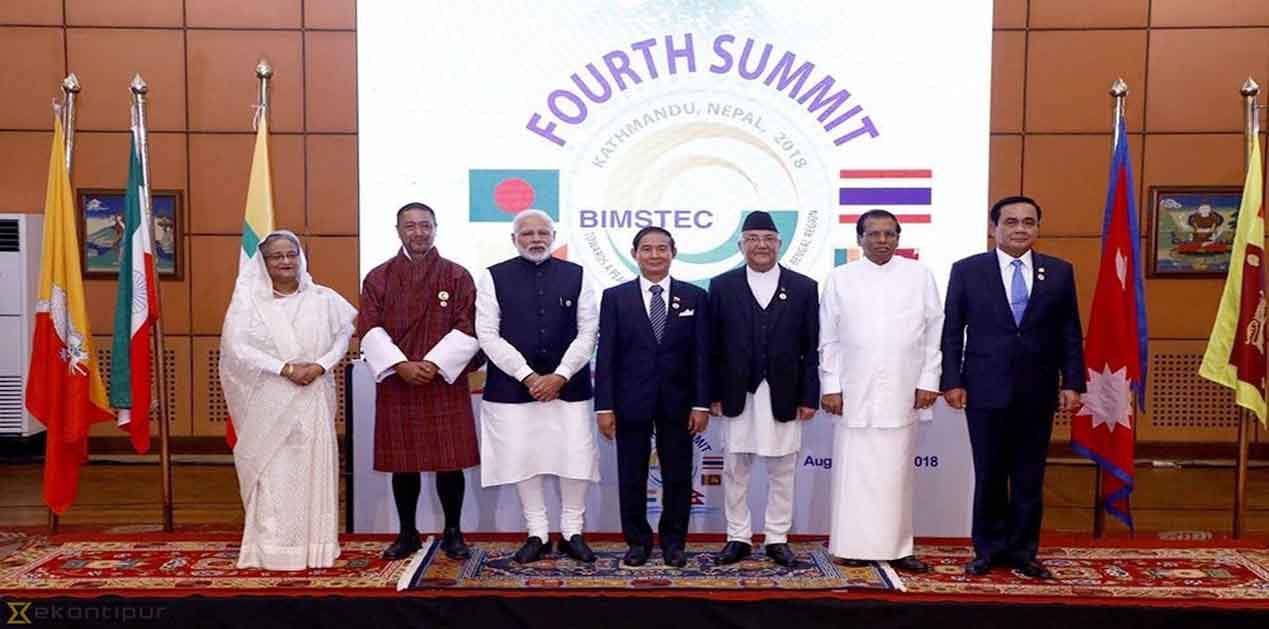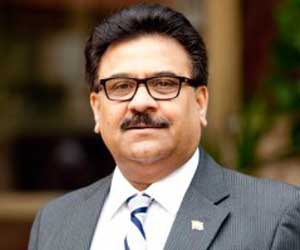On August 30-31, the seven-member Bay of Bengal Initiative for Multi-Sectoral Technical and Economic Cooperation (BIMSTEC) held its 4th Summit at Kathmandu within a span of over two decades. Many observers had begun to cast a shadow of doubt on its relevance or its members’ commitment to the cause that in the first place led to the establishment of the grouping in 1997 through the Bangkok Declaration. Its lacklustre performance and inadequate leadership commitment and financial strength made the doubters even more critical. Of course, one could always hide behind the analogy ‘whether the glass is half full or half empty’. BIMSTEC‘s relevance and raison d’ etre are very much intact but it had begun to suffer by the same malaise that afflicts most of the multilateral institutions - alacrity of verbosity, high on promise and low on delivery - at least until now!
BIMSTEC comprises of Bangladesh, Bhutan, India, Nepal, Myanmar, Thailand and Sri Lanka. India obviously is the largest economy and strategic pivot for this not so nascent organisation. Hence a lot will depend on how India makes the resources available and remains a major stakeholder and driver without invoking the ‘Big Brother Syndrome’ and perceived supremacy that has stunted the growth and integration of other fated regional outfit in the form of the South Asian Association for Regional Cooperation, or SAARC.
SAARC of course did not move well due to the prolonged rift between India and Pakistan and broadly due to Pakistani intransigence and ill-founded approach. Bilateral context undermined the regional effort that was further undermined by Pakistan’s continued support to terrorist groups operating against India. Some movement on that forum appears likely too with the new Pakistani Government of Imran Khan. EAM Sushma Swaraj is slated to meet her SAARC counterparts on the side-lines of UN General Assembly and the next Summit in Pakistan would be a natural point of discussion, provided Pakistan gives reasonable assurances for the concerns of the member countries.
On the other hand, for India, BIMSTEC happened to be the real connectivity bridge between South Asia and South East Asia in accordance with India’s now vigoured Act East Policy. It also provided India with an alternative to the stalled SAARC process, focussing more on sub-regional cooperation so that India’s and the region’s core interests are not affected beyond redemption. India has further gone ahead with BBIN (Bangladesh, Bhutan, Nepal and India comprising of four out of seven BIMSTEC members) initiative and success on this front could provide a format be it a Motor Vehicle Agreement or other connectivity projects for the BIMSTEC itself. At the same time, it can also be a viable Indian alternative to China’s One Belt One Road (OBOR) that seeks to encompass various regions and several of the BIMSTEC members who are engaged with China but somewhat wary of the protruding debt traps. But for that, concrete and clear progress is inevitable in the BIMSTEC and sub-regional context.
India will need to focus and prioritise its connectivity and infrastructural outreach in the Asian region. In the sub-regional context, India by virtue of its size and strength, will have to fork out majority of financial and capacity building requirements. To what extent can it pitch in without overstretching is the moot question. Besides, China will continue to poach into our South Asian neighbours and play upon their fears of the Big Brother Syndrome alluded to India. Hence, they would continue to seek out both India and China in order to strategically balance their dependency. Therefore, while playing a critical role as an engine for BIMSTEC and other regional and sub-regional groupings, India has to strategically calibrate its power projection and proportionate financial commitments. It is a fact that until the Goa Retreat on the side-lines of BRICS Summit, India’s financial commitment was insignificant and it had not even appointed a Director to the fledging BIMSTEC Secretariat. Such lacunae could easily decimate the claims to a leadership position and the confidence of its smaller partners who might look to it. Hence India took a significant lead to address the key issues at Kathmandu.
The 4th Summit attached a great deal of importance to poverty alleviation as with 22 per cent of the global population, the BIMSTEC may also be comprising of the highest number of poor people. Hence the BIMSTEC Declaration spoke of “Towards a Peaceful, Prosperous and Sustainable Bay of Bengal Region”. It recognized that eradication of poverty was the greatest regional challenge in realization of development objectives and expressed firm commitment to working together for the implementation of the ‘Agenda 2030 for Sustainable Development’. Acknowledging that enhanced inter-linkages and inter-dependence within the economies and societies in the BIMSTEC member states provide greater opportunity to advance regional cooperation, the members decided to set up a BIMSTEC Development Fund in an institutionalised manner. However, the use of words “at an appropriate time” and through “voluntary contributions” seem to have inserted an uncertainty about it. As such, the originally agreed 14 areas of focus have been reduced to five as envisaged in the Concept Paper of Thailand and welcomed by the BIMSTEC. Although it is good to have realistic targets, diluting the core objectives may have its down side.
In order to carry forward the aims and objectives of the Organisation it is important to have a strong, functional and well-funded Secretariat. Fortunately, the Declaration endorsed this view by stating, “agree to enhance the institutional capacity of the BIMSTEC Secretariat, including through financial and human resources, in order to enable it to coordinate, monitor and facilitate implementation of BIMSTEC activities and programmes”. To initiate project proposals as agreed by the Member States as well as to fulfil any other responsibility entrusted to it in an effective and efficient manner, it was agreed to raise the numbers of Directors to seven, one from each Member State, in a staggered manner. Additional funding has also been committed. Hopefully the Secretariat will now follow on key issues and tasks assigned to them for the Filth Summit.
Another key area from India and the region’s perspective is the issue of terrorism which has clearly been proclaimed in the declaration. It reads, “Recognizing that terrorism and transnational organized crimes continue to pose a great threat to international peace and security including in the BIMSTEC countries, and stressing that combating terrorism and transnational organized crimes require sustained efforts and cooperation and comprehensive approach involving active participation and collaboration of the Member States … deplore terrorist attacks in all parts of the world including in BIMSTEC countries and strongly condemn terrorism in all its forms and manifestations wherever and by whomsoever committed and stress that there can be no justification whatsoever for any act of terrorism … affirm that the fight against terrorism should target not only terrorists, terror organizations and networks but also identify and hold accountable States and non-State entities that encourage, support or finance terrorism, provide sanctuaries to terrorists and terror groups and falsely extol their virtues … reiterate our strong commitment to combat terrorism and call upon all countries to devise a comprehensive approach in this regard which should include preventing financing of terrorists and terrorist actions from territories under their control, blocking recruitment and cross-border movement of terrorists, countering radicalization, countering misuse of internet for purposes of terrorism and dismantling terrorist safe havens.” The meeting of National Security Advisors will continue to remain the key driving mechanism for addressing the counter-terrorism and security issues – a mechanism that is functioning well.
Trade and Investment as well as free movement of goods, services and people remain a key area of cooperation that is so intrinsic to ensuring functional and feasible connectivity. Hence it was decided to “Renew our commitment to an early conclusion of BIMSTEC Free Trade Area (FTA) negotiations, and direct the BIMSTEC Trade and Economic Ministerial Meeting (TEMM) and its subsidiary bodies including the Trade Negotiating Committee (TNC) to expedite finalization of all related Agreements of the BIMSTEC FTA as early as possible … and express our satisfaction on the progress of negotiation on the Agreement on Trade in Goods and the Agreement on Customs Cooperation … also direct our respective Ministries/Agencies to participate regularly in TNC Meetings”. Members further agreed to revitalize the activities of BIMSTEC Business Forum and BIMSTEC Economic Forum to further strengthen Government–Private sector cooperation for the promotion of trade and investment, and task the Expert Group on BIMSTEC Visa Matters to continue negotiation for finalization of the modalities for the BIMSTEC Visa Facilitation. India offered to host a BIMSTEC Start-up Conclave in December 2018, and encouraged all Member States to participate in it. These are good initiatives that need to be actively pursued in a timebound manner since the trade and investment flows are abysmal.
BIMSTEC is a unique sub-regional collective that encompasses the complementarities of the maritime economy and security with ‘Mountain Economy’. India in the past has been a trading nation with dozens of good ports and a reliable shipping lines and routes. India’s recent SAGAR (Security and Growth for all in the Region) initiative is relevant for the members since it seeks to defend national interests through deepening of economic and security cooperation by engaging in collective action for peace and security and deepening regional integration based on sustainable development. It is in the interest of all stakeholders, especially the leaders, to give their best - and not just the ‘timely holding of Summits’ lest it becomes another Rubik’s Cube - and to make the BIMSTEC a real success story that will benefit them all in the long run.
Image Source: http://assets-cdn.ekantipur.com/images/the-kathmandu-post/miscellaneous/bimestec4-3182018083619-1000x0-31082018123449-1000x0.jpg










Post new comment